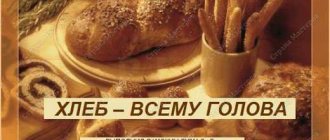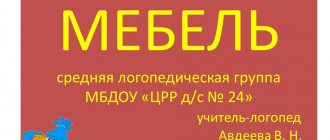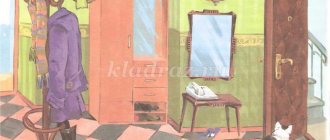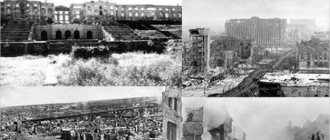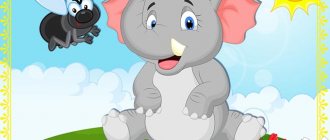“Retelling the story “Where the bread came from” - compiling a series of plot pictures”
Transcript
1 Municipal budgetary preschool educational institution of a combined type d/s 40 “Snowdrop” of a combined type Abstract of an open lesson on speech development in the senior group “Retelling the story “Where the bread came from” - drawing up a series of plot pictures” Compiled by: teacher of the 1st qualification category Sorokina Ekaterina Aleksandrovna Osinnikovsky urban district 2014 1
2 Topic: Retelling the story “Where the bread came from” - compiling a series of plot pictures. Goal: To clarify and consolidate children’s understanding of growing bread; consolidate knowledge about who grows bread, where and from what; what grains are flour made from, what types of bread are there. Learn to write a story using pictures. Foster a caring attitude towards bread, respect for the work of the people involved in its cultivation, and cultivate an environmental culture. Material: ball, Move: I. Guys, I’ll now tell you a riddle, and you try to guess it. And then you will know what I want to tell you about. He is black, he is white, and he is always tanned. Whenever we want to eat, we always sit down with him. (Bread). Today we will find out where the bread came from in the bread department of the store. II. Game “Name the profession” Who works on the tractor? Who works on the combine? Who grows the bread? Who works at the mill? Who works at the bakery? III. Children, let us imagine that we are spikelets in a field and do an exercise called “Spikelets” (an exercise to develop coordination of movements “Spikelets”) 2
3 In the spring the field was plowed. The field was sown with grain. The sun is hot. The earth is warmed. The spikelets have risen high, They are reaching for the sun. The wind blows, Koloski shakes. They bent to the right, and swung to the left. And as the rain falls, the driver drinks and drinks Rye. What a field! How beautiful she is. Children make sliding movements of their palms against each other. They touch the fingers of one hand to the palm of the other and move the hand to the side (“sow”). They cross their palms, spread their fingers, raise their hands (“sun”) Lower their hands, making springy movements with their palms open to the floor. Bend your elbows, turn your palms towards each other and slowly raise your arms. They swing their arms above their heads. Tilt the body and arms to the right and left. Slowly they lower their hands. Moving my fingers quickly. Cup your palms and bring them to your mouth (“drink”) Raise your hands, fingers spread. Shake hands above head IV. Examination of a series of paintings followed by discussion. 1. What time of year is shown in the first picture? 2. Where does the tractor work? What is the name of the profession of a person who works on a tractor? 3. What work does the tractor do? 4. What is the name of the technique in the third picture? What work does a seeder do? 5. What work does the plane do? Why do you need to fertilize the field? 6. When does wheat ripen? 7. What is used to harvest wheat? What is the name of the profession of a person who works on a combine? 8. What is bread made from? 9. What needs to be done with wheat grains to make flour? 10. Where are beeches and loaves baked? Who bakes them? 11. Where is the bread then taken? 12. How should you treat bread? 3
4 VI. Compose a story together with the teacher. Spring has come. The snow has melted. Tractor drivers went out into the field to plow and loosen the soil for future grain. The grain growers sowed grain into seeders and began to scatter it across the field. And then a plane took off into the sky to fertilize the wheat field. The fertilizer will fall into the ground, and the wheat will grow and ripen. By the end of summer, the wheat field will be in full bloom. Combine operators will go out into the field. Harvesters will float across a wheat field, as if across a blue sea. The threshed grain is ground into flour. In the bakery they will bake warm, fragrant bread from it. And they will take you to the store. VII. Game “Name it affectionately” 1. Ear 2. Loaf 3. Grain 4. Bagel 5. Bagel 6. Loaf 7. Land 8. Store, etc. VIII. Physical education lesson: The snow will melt in a clean field, the melt water will subside - it will run after the tractor driver to the blue furrow river. Then the seeders will come out to sow the fields with grain. 4
5 IX. Continuation of children's stories. X. Summary of the lesson. Where did the bread grow? What was it made from? Where bread is baked, and what professions people worked to grow bread. We learned that there is such a profession as a grain grower who grows bread. XI. Children are invited to recite poems about bread. 5
Summary of a subgroup speech therapy lesson in the senior group for children with special needs on the topic “Bread”
Summary of a subgroup speech therapy lesson in the senior group for children with special needs on the topic “Bread”
Author. Speech therapist teacher, Svetlana Vyacheslavovna Klokova. Description. The outline of a speech therapy lesson will be of interest to speech therapists, special education teachers and parents. The summary is written in detail and contains the children's expected answers. The lesson belongs to the third period of study. By this period, the dialogical form of speech is being improved, so it is advisable for the teacher to demand a complete response from the children. The summary is written for children with ODD, level 3 of speech development. Target. Clarifying and expanding children's knowledge about bread. Correctional educational tasks. Activate your vocabulary on the topic “Bread”. Clarify ideas about the work of grain growers and the importance of their work. Improve the skill of viewing a picture, continue to form a holistic view of what is depicted on it. Improve the grammatical structure of speech. Corrective and developmental tasks. Develop speech hearing, visual attention and perception, general speech skills, coherent speech, thinking, memory, articulatory, fine and gross motor skills, coordination of speech with movement. Educational tasks. To cultivate goodwill, mutual understanding, cooperation skills, initiative, independence, responsibility. To develop a sense of love for nature and respect for it. Equipment. Painting by V.M. Carat “Golden Rye”, magnetic board, subject pictures with bakery products, dried ears of rye and wheat, a bag with bakery products. Preliminary work. Visiting a bread store with parents, looking at pictures of the work of grain growers, learning the “Golden Rye” exercise.
Progress of the lesson
1. Organizational moment. The speech therapist greets the children, asks them to stand around him and invites them to play the game “Magic Bag”. Speech therapist. Guys, now you will take turns putting your hand into the bag, feeling one of the objects that is there, and guessing its name. Tell me by what signs you guessed this. When you name all the subjects, we will know what we will talk about in class today. Children take turns putting their hand into the bag, feeling for objects and telling how they know what kind of object it is. Child. I felt the bagel. It's round and big. Child. I felt for a cracker. It is oval and hard. Child. I felt for drying. It is round and small. Child. I felt the cookie. It is square and thin. Speech therapist. Well done guys, you guessed all the items perfectly and explained in detail how you did it. Think about what all these bread products were made from? Children. Made from flour. Speech therapist. Right. What is it made of? Children. From wheat grains. Speech therapist. Fine. Today we will talk about how grain is harvested in the field. You can't get rye bread, long loaves, rolls while walking. People cherish bread in the fields, they spare no effort for bread. 2. Making riddles. Speech therapist. All cast from gold, standing on a straw. Children. Spikelet. Speech therapist. It stands like a wall, It makes noise like a wave, It’s a golden wave, You can’t see the edge. Children. This is a field of rye. Speech therapist. Everything is correct! It was not by chance that I asked you riddles about the spikelet and the field of rye. Now we will look at the painting “Golden Rye” and compose a story based on it. 3. Looking at the picture and talking about it. The speech therapist places a picture on an easel and conducts a conversation around it. Speech therapist. Guys, the artist called his painting “Golden Rye”. Why do you think. Children. Because the picture shows a field of rye. She has matured and become like gold. Speech therapist. Right. What colors does the artist use to show the “golden rye”? Children. The artist uses bright yellow paint. Speech therapist. Fine. What can you say about the field? Children. It is big, wide, “golden”. Speech therapist. Right! What kind of sky do we see above the field? Children. Tall, blue, clean. White clouds are floating across the sky. Speech therapist. Children, what do we see between the field and the sky? The speech therapist shows the horizon line. Children. We see a green forest in the distance. Speech therapist. If the forest is still green. What season do you think is depicted in the picture? Children. Summer. Speech therapist. Right. Summer is not over yet, it’s August, the last month of summer. Grain growers began to harvest crops from the fields. What technique helps to remove rye? Children. Combine and dump truck. Speech therapist. Describe. What are they like and what do they do? Children. A large red combine cuts off ears of rye and pours the grains into the back of a dump truck through a special pipe. Blue dump truck. He drove close to the combine so that the rye grains did not spill onto the ground. Speech therapist. That's right, guys. When the grain harvest from the fields begins, all grain growers work from early morning until late at night, because... You need to harvest the crop before the rains in dry weather. And at this time, many combines and many dump trucks go to the field. Did you like this picture? Children. Yes, we liked the picture. It depicts beautiful nature with bright colors and working people. Speech therapist. You also worked well in class, I suggest you take a break. Let's play the game "Golden Rye". 4. Physical education minute. The speech therapist invites everyone onto the carpet and asks them to do the exercises.
The spikelets stand swaying in a golden field.
(Children with raised hands stand and swing in different directions.)
Grain growers fill the carts with grain.
(Children walk in a circle, hands in front folded in a “cup”; turn the “cup” over into a circle.)
5. The teacher communicates the plan for the story based on the picture.
The speech therapist invites the children to sit on chairs. Speech therapist. Guys, I suggest you tell the story according to plan. First you tell about the field, then about the sky, the forest in the distance. Then about the cars depicted in the picture. At the end, tell me why you liked this picture. Children tell the story in parts.
Then one child tells the entire story. 6.
End of class. The speech therapist evaluates the children’s work and asks them to remember what they did during the lesson. What is the name of the profession of people who grow bread? He clarifies that this is very difficult and necessary work.
We recommend watching:
Summary of an individual educational activity with a 5-6-year-old pupil for the correction of sound pronunciation. Notes of an educational activity in a senior speech therapy group. Notes of a lesson in a senior speech therapy group. Notes of an individual correctional and developmental speech therapy lesson. Senior group
Similar articles:
Summary of educational activities in the older group of children with severe speech impairments on the topic: “Sounds S - Z”
Summary of educational activities in the senior group of children with severe speech impairments on the topic: “Sounds S - Sh”
Summary of a subgroup GCD to eliminate disturbances in sound pronunciation in children of the older group with severe speech impairments
Summary of educational activities in the senior speech therapy group on the topic “Cossacks and their traditions”
Logorhythmic lesson for children of senior preschool age with special needs on the topic: “What types of transport are there?”
